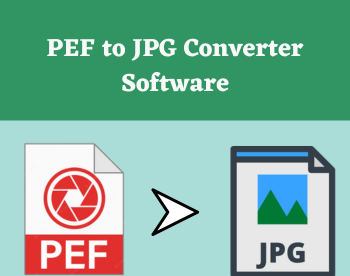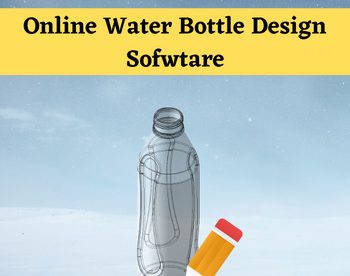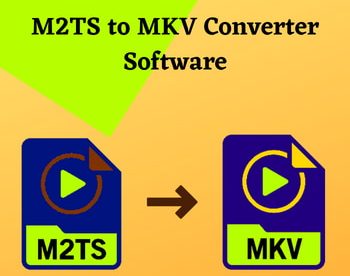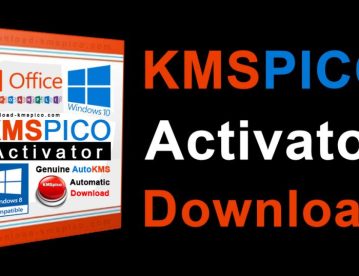14 Best Free Molecule Viewer Software For Windows
Here is a list of best free molecule viewer software for Windows. These software are helpful to science enthusiasts to visualize and study molecular structures in 3D. In order to view molecule structures, you need to import a molecule file. Most of these molecule visualization software support different file formats including Protein Databank (PDB), Molecular Model Files (XYZ), Alchemy File Format, Sybyl MOL2 Format, MDL Mol File Format, CIF File Format, MOPAC File Format, etc. The properties of molecules are also displayed in these which include statistics related to atoms, bonds, mass number, atomic number, etc. In some of these, you can even edit molecules or build molecule files from the scratch.
To ease the process of molecular visualization, these provide all essential and some advanced display and navigation tools. You can customize displayed molecule structure by changing molecular rendering style such as Wireframe, Backbone, Sticks, Spacefill, Balls & Stick, Ribbons, Strands, etc. Furthermore, you can customize preferences like show labels, color schemes, point light, depth cueing, halos, ambient light, borders, etc. You can easily navigate through molecular structure using tools like zoom in/out, rotate, auto-rotate, move, spin, etc.
You can also export the customized molecule structure as an image in all of these molecule viewer software. Plus, a few of these allow you to create an animation of molecules too.
My Favorite Free Molecule Viewer For Windows
From this list, I liked IQmol the most. It is a feature rich 3D molecule viewer as well as molecule editor software. Plus, its interface is nicely designed which provides a good molecule visualization experience. Molekel is my second favorite as it supports a good number of molecule file formats. Avogadro is nice too because you get some additional tools like Animate Trajectory, Optimize Geometry, Calculate Energy, Setup Force Field, Crystallography, etc.
You may also like some best free Molecular Modeling Software, Chemical Reaction Simulators, and Molecular Mass Calculators for Windows.
IQmol
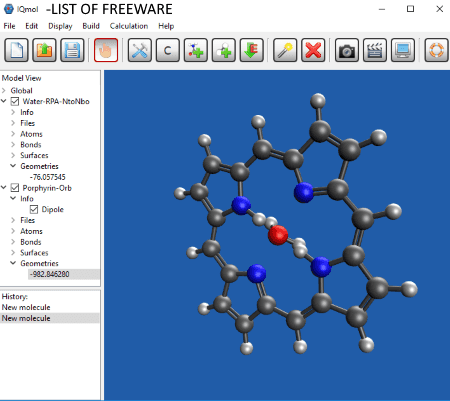
IQmol is a free open source molecule viewer as well as molecule editor software for Windows. It provides a good number of tools to visualize molecule structures and study molecule properties.
To view molecules, you can open a molecule file like PDB, MOL, CUBE, etc. The exact supported import formats are not clear as it doesn’t mention them. As you open a molecule file, the respective model view can be seen from the left panel. It includes atoms, bonds (bond length), geometries, etc. You can add and configure surface too by specifying type (Van Der Waals, Promolecule, SID), Isovalue, color, opacity, quality, etc. To view molecules, it lets you setup display properties such as show axes, camera configurations (projection, rotation, positions, etc.), appearance (shader, POV-Ray), atom labels (element, index, mass, NMR, partial charge, spin density,), etc. It lets you view and analyze molecules in full screen mode too. You can rotate the structure, zoom in/out, spin it, etc. At last, you can save the displayed molecule structure as a PNG, BMP image, etc. It provides an option to record animation which basically saves each frame of animation as BMP image.
As it is a molecule editor too, you can build or edit molecules. From its Build menu, you can find options like Insert Molecules by ID, Fill Valencies With Hydrogens, Set Isotopes, Set Geometric Constraints, Minimize Structure, Select Force Field, Symmeterize Molecule, Set Symmetry Tolerance, etc. After building or editing molecules, you can save them in a file. The file formats to save molecules include XYZ, PDB, CML, MOL, GZMAT, etc. It provides an option of Q-Chem calculations too.
All in all, it is a great molecule visualization software which has a clean and intuitive user interface. It provides a dedicated History section also to view all performed actions.
Molekel
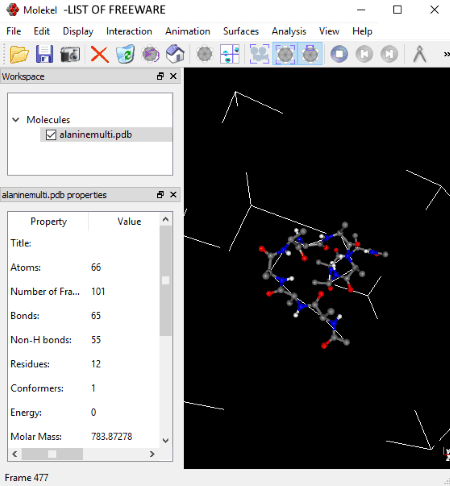
Molekel is a nice 3D molecule viewer with a clean GUI. In it, you can open molecule files and then visualize and study molecules by customizing several display options. To input a molecule file, it supports a wide range of formats which include PDB, XYZ, YOB, ALC, SDF, SMI, RXN, PCM, PQS, MOL, MOL2, TMOL, and some more. As soon as you import a molecular file, you can view its visual representation and properties on the main interface. The properties include statistics related to atoms, bonds, energy, residues, conformers, molar mass, exact mass, spin multiplicity, charge, vibration frequencies, etc. Coming to molecule visualization, here are the features provided by this freeware:
- Molecule display settings like molecule form (CPK, stick, ball & stick, wireframe, etc.), atom form (hemisphere, sphere, billboard, etc.), bond form, residue, atom detail, atom color, scaling, etc., can be configured.
- In addition, it lets you customize background and 3D view properties and enable/disable plane probe, MEP scalar bar, bounding boxes, axes, etc., view options.
- You can rotate, spin, or zoom in/out the molecular structure using your mouse.
- It provides different interaction modes to enhance the viewing experience including Camera, Molecule, and Pick Atom/Bond.
- It lets you visualize surface generated with electron density, grid lines, solvent accessible surface, and solvent excluded surface. The solvent accessible surface and solvent excluded surface are first computed as you specify related parameters.
- It lets you open different molecule files and visualize them all at once. So, in that way, you can merge and save molecule file in any of supported formats.
- You can save the molecular view as an image (PNG, TIFF), PostScript, EPS, or PDF file.
- Some additional analysis tools are available in it which include Plane Probe, Radiation Spectrum, etc.
Avogadro
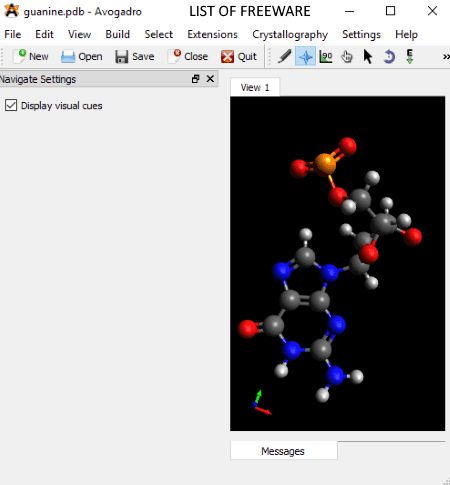
Avogadro is a free, open source, and cross-platform molecule viewer in this list. It is a molecule creator and editor software as well. In order to visualize molecules, you can import a file in formats like PDB, CML, CIF, FCHK, GAMOUT, MOL, MOL2, SDF, DMOL, etc. Molecules can be visualized in Perspective or Orthogonal projection. The basic view options like rotate, zoom in/out, selection, etc., are available in it. In addition, you get an auto-rotation tool, auto-optimization tool, detach view, full-screen mode, and align molecules option. It provides an advanced selection feature which lets you select by element, residue, SMARTS pattern, solvent, etc. You can view molecule, atom, bond, angle, torsion, and conformer properties too. The molecule representation can be exported as PNG, BMP, or JPEG image. You can also export vector graphics (PDF, SVG, EPS), POV-Ray, and VRML model.
You can build molecules in it using tools like Add Hydrogens, Insert Fragment, DNA/RNA, SMILES, and Peptide, Super Cell Builder, Nanotube Builder, Change H to Methyl, Cartesian Editor, etc. Many advanced tools like Animate Trajectory, Optimize Geometry, Calculate Energy, Setup Force Field, Crystallography, etc., are also available. It contains various plugins which help you analyze molecule structures like interact with molecules, create input file dialogs for quantum codes, generate molecule property dialogs, create surfaces, etc.
Molegro Molecular Viewer
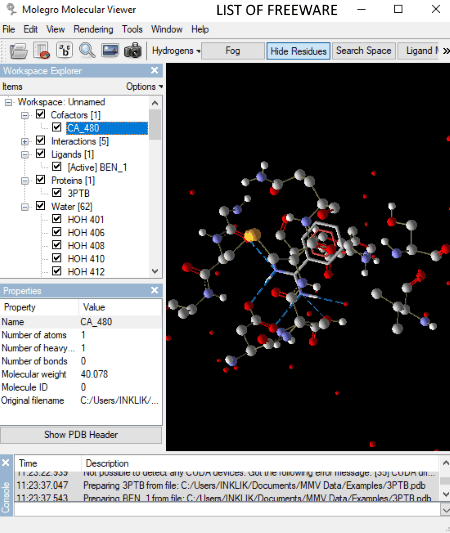
Molegro Molecular Viewer is one more molecule visualization software which comes with a well-designed interface. You can directly import molecules from MOL, MOL2, PDB, SDF, SD, MDL, MVDML, and ENT molecule files. As you do that, different aspects of the imported file are listed at left panel such as ligands, protein, water, cavities, cofactors, etc., with respective properties. A visual representation is also displayed on the interface. The view can be set to dock view, hydrogen bond interaction, preparation view, hydrophobicity, electrostatic interaction, pose organizer view, or secondary structure view. You can hide residues and fog too. It lets you setup rendering options to set display options for protein, ligand, pose, cofactor, and water, such as geometrical representation (wireframe, ball & stick, stick, spacefill), color, etc. You can capture the molecule structure and save it as PNG, JPEG, or BMP image.
Additionals tools of this 3D molecule viewer include Pose Organizer, Create Labels, Create Surfaces, RMSD Matrix, Sequence Viewer, Biomolecule Generator, Ligand Energy Inspector, Structure Protein Alignment, Ligand Map, Energy Map, etc.
Jmol
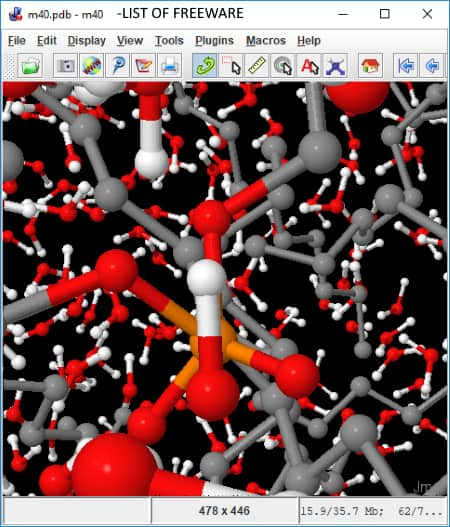
Jmol is the next free open source 3D molecule viewer for Windows. It is also portable, so you can run it without installation. To view molecule structure, you can open PDB, MOL, etc., molecule files. You can customize various view settings like atom size, bond radius, show measurements, display labels, show axes, etc. To properly analyze molecular structure, use options like rotate, zoom, etc. It provides some useful tools such as Measurements, Animate, Surface Tool, AtomSetChooser, etc.
It provides several export options to render the current molecular scene. These include Export Image, Export To Web Page, Render in POV-Ray, etc.
Bioclipse
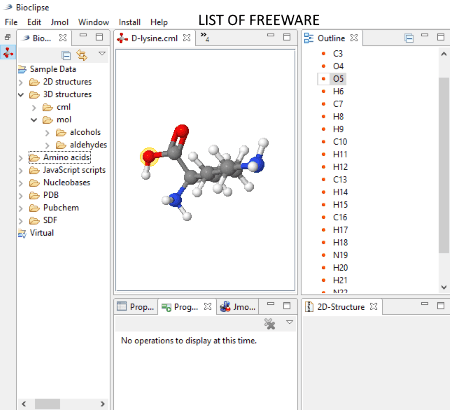
Bioclipse is a free and portable molecule viewer for Windows. In it, you can browse various molecular files and view respective molecule structures in 3D. It provides a nice Bioclipse navigator to easily navigate through added files. Different molecule structures can be visualized due to its multi-tab interface. An outline of the molecule file containing atoms is displayed in the right panel. You can also select an atom, bond, or molecule from the structure and view its respective properties like atomic number, mass number, symbol, bond order, etc. A 2D structure of opened molecule file is also displayed on the interface.
Now, talking about its display and navigation options, you get all standard viewing tools in it. These include rotate, zoom, move, spin, etc. Also, you can customize rendering style (atoms, label, scheme, bond, etc.), colors, measurements, etc. The customized molecule structure can be exported as JPG, PNG, POV-RAY, VRML 3D Model, X3D 3D Model, Maya 3D Model, etc., files.
RasMol
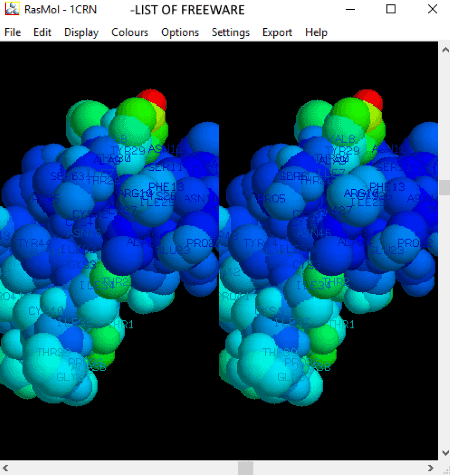
RasMol is a free open source molecule viewer for Windows. It lets you visualize molecules in different display modes including Wireframe, Backbone, Sticks, Spacefill, Balls & Stick, Ribbons, Strands, Cartoons, and Molecular Surface. You can change the color of molecules to monochrome, structure, chain, group, model, user, temperature, etc. To visualize molecules, you can also use options including Slab Mode, Hydrogen, Hetero Atoms, Specular, Shadow, Stereo, and Labels. You can rotate molecule bond too.
For molecule visualization, it supports files including Protein Databank, Alchemy File Format, Sybyl MOL2 Format, MDL Mol File Format, CIF File Format, MOPAC File Format, etc. After opening a file, you can also view related information which includes molecule name, classification, database name, and number of chains, groups, atoms, and bonds. You also get a dedicated Export menu to export molecular display to different files such as BMP, GIF, IRIS RGB, PPM, Sun Raster, Post Script, POVRay, VRML, Raster3D, etc.
QuteMol
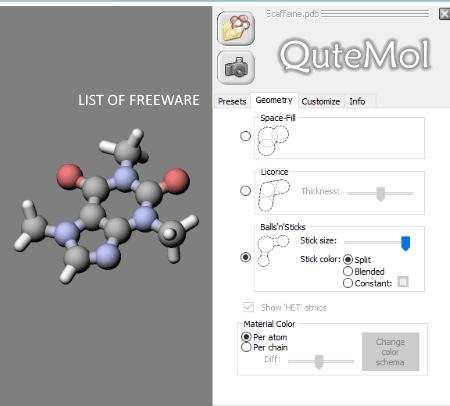
QuteMol is the next free 3D molecule viewer for Windows. For molecule visualization, it supports molecular files in Protein Data Bank File (PDB, VDB) format only. A display preset can be chosen to view molecules such as Realistic, Direct Light Only, Illustrative, Cool, Simulated, etc. You can also customize display as per your preference. The molecules can be viewed by customizing geometry. You can select Space Fill, Licorice (with thickness), or Balls’n’Stick display option and also change material color. It also lets you setup various other preferences to visualize molecules. These include customizing base color, background, point light, depth cueing, halos, ambient light, borders, etc. If you wish, you can save the current display of molecules as an image including JPG and PNG. Also, creating a GIF animation of molecules is also possible.
PubChem
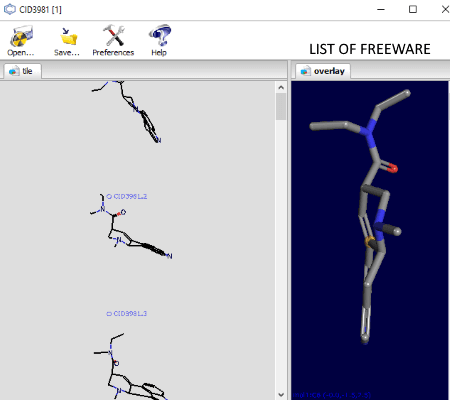
PubChem is another one of simple molecule viewer software for Windows. It lets you browse molecule files and then visualize molecule structure in 3D. To import a molecule file, apart from its native formats, it supports SD Files (SDF), Compressed Molecular Files (GZIP), and Molecular Model Files (XYZ). As you open a file, it displays molecules in both tiled and overlay structures. So, you can view single molecule structure or multiple molecules in tiles. To view molecule, you can use options like rotate, scale, zoom, align, etc. Also, you can customize display options like atoms, bonds, molecules, box, symbol, etc. You can save overlay molecular structure as PNG and JPEG images.
Using the Preference button, you can configure options like image quality, light model, background color, viewing angle, scale strategy, orthogonal projection, atom scale, atom coloring, atom info, bond coloring, bond info, bond width, etc.
VMD
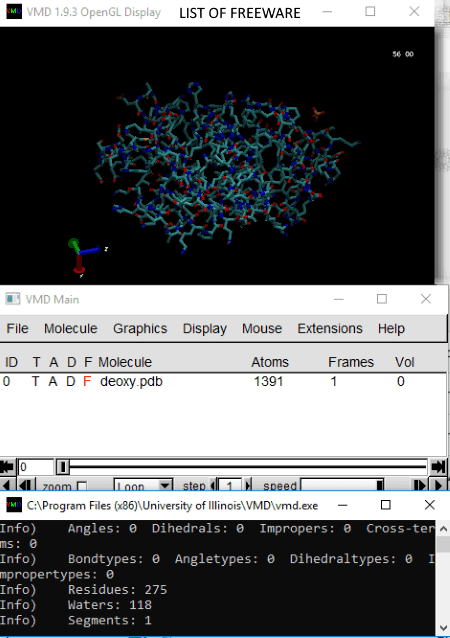
VMD is yet another 3D molecule viewer for Windows. It provides separate windows in order to import and manage molecule files and for molecule visualization. It supports quite a number of file formats to import molecules, such as PDB, OFF, MOL, PLY, PQR, GRASP, Tinker, etc. Using its File > New Molecule option, you can browse a molecular file in a supported format. As you do that, it displays file information and 3D molecule view in dedicated windows. You can open multiple molecule files and toggle between each of them to view respective molecules.
Like other molecular visualization software, it also lets you customize molecular view by configuring representation, color, materials, and labels. For better molecule viewing experience, you can use options like automatic rotation, perspective or orthogonal view, FPS indicator, change background, stereo, stage, render mode, etc. Furthermore, you can configure your mouse in rotation, translate or scale mode, add atom, bond, angle, or dihedral labels, add or remove bonds, etc. To save the current molecular scene as an image, use File > Render option and manually enter image format extension. You can also use other techniques to render and save current molecular display such as STL, Raster3D, POV-Ray, VRML, Wavefront, etc.
VMD also provides some extensions for different functions such as Analysis, Modelling, Simulation, Tk Console, etc. For molecular visualization, it offers extensions like Camera Navigator, Movie Maker, ViewMaster, Palette Tool, Virtual DNA Viewer, etc.
BALLView
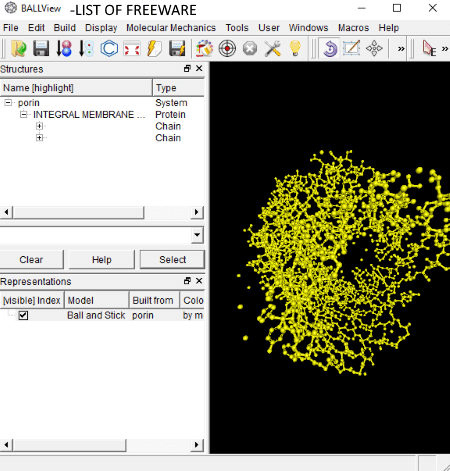
BALLView is one more molecule visualization software for Windows. The molecular files supported in this software include PDB, HIN, BRK, ENT, MOL, MOL2, SDF, AC, and XYZ. Here are some of its features which ensure a nice molecular visualization experience:
- You can customize view as per your preference such as colors, drawing mode (wireframe, dots, solid, toon), material settings, display model (ball & stick, stick, backbone, ribbon, forces, etc.), etc. Also, you can configure camera settings, create clipping plane, labels, etc., enable rotate/pick/move mode, etc.
- Some molecular mechanics tools like Single Point Calculation, Energy Minimization, and Molecular Dynamics are also available in this software.
- It lets you export displayed molecular structure as PNG image, POV-Ray Scene, or 3D Prototyping Data file.
Apart from molecular visualization, it lets you create molecules using tools like Build Peptides, Build Bonds, Add Hydrogen, Assign Bond Orders, etc. It also supports loading Python scripts and extra plugins and lets you calculate secondary structure, H-bonds, and FDPB electrostatics.
UGENE
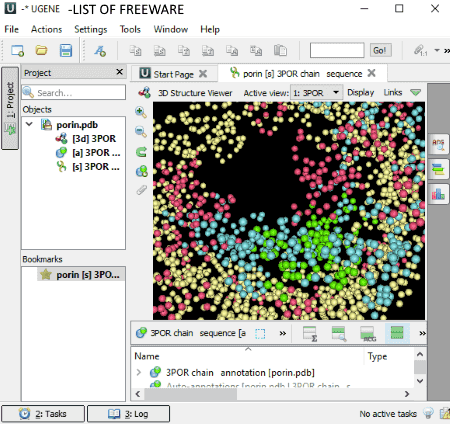
UGENE is a free open source bioinformatics software which can be used as a molecule viewer for Windows. It supports a lot of file formats to import and analyze nucleic acid and protein sequences.
To visualize molecules, you can open a PDB, MMDB, etc., file and view its 3D structure in a dedicated section. You can customize various display settings which include rendering style, color schemes, molecular surface rendering style, set background color, etc. You can also spin the molecules, align the structure, and later export the molecular structure as a file (PNG, JPEG, BMP, SVG, TIFF, PDF, etc.).
To know more about its key features, check this link.
COSMOview
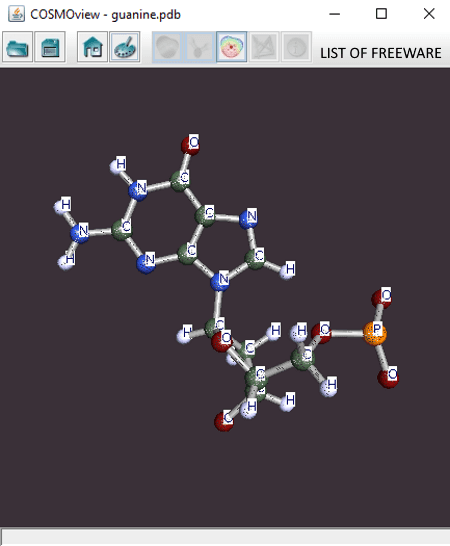
COSMOview is another software which lets you open molecule files and visualize molecules in 3D. To open a file, it supports PDB, CCF, Energy, XYZ, WRL, SDF, etc., formats. It is quite a basic molecule viewer as compared to other software in this list. It provides basic view options which include window size, disc smoothness, background color, atom properties, bond options, and label properties. You can rotate or zoom in/out the molecule view using your mouse. If you wish, you can save the molecular display as a PNG image.
Zeus PDB Viewer
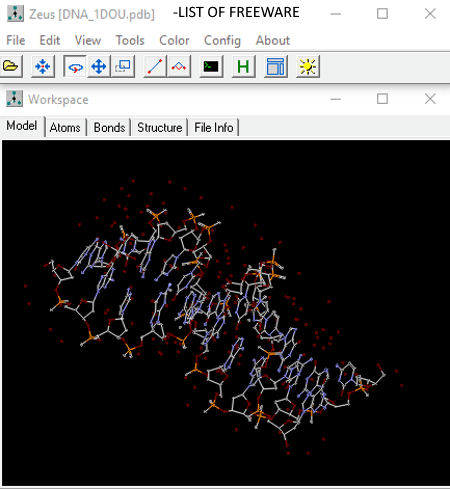
Zeus PDB Viewer, as the name suggests, is a PDB molecular file viewer for Windows. Apart from PDB file, it supports MOL, MOL2, XYZ, etc., files. Along with molecule structure representation, it displays a Residue List too. You can also view atoms, bonds, structure, and file details. You can change the geometry of molecules to wireframe, ball & stick, balls & wire, triangular tubes, square tubes, or space filling. You can also enable auto-rotate feature. It provides some useful tools including Compute H-Bonds, Bond Non-Bonded Atoms, Show Model Sequence, Find Sequence, etc. You can export molecular structure as a BMP image.
About Us
We are the team behind some of the most popular tech blogs, like: I LoveFree Software and Windows 8 Freeware.
More About UsArchives
- April 2024
- March 2024
- February 2024
- January 2024
- December 2023
- November 2023
- October 2023
- September 2023
- August 2023
- July 2023
- June 2023
- May 2023
- April 2023
- March 2023
- February 2023
- January 2023
- December 2022
- November 2022
- October 2022
- September 2022
- August 2022
- July 2022
- June 2022
- May 2022
- April 2022
- March 2022
- February 2022
- January 2022
- December 2021
- November 2021
- October 2021
- September 2021
- August 2021
- July 2021
- June 2021
- May 2021
- April 2021
- March 2021
- February 2021
- January 2021
- December 2020
- November 2020
- October 2020
- September 2020
- August 2020
- July 2020
- June 2020
- May 2020
- April 2020
- March 2020
- February 2020
- January 2020
- December 2019
- November 2019
- October 2019
- September 2019
- August 2019
- July 2019
- June 2019
- May 2019
- April 2019
- March 2019
- February 2019
- January 2019
- December 2018
- November 2018
- October 2018
- September 2018
- August 2018
- July 2018
- June 2018
- May 2018
- April 2018
- March 2018
- February 2018
- January 2018
- December 2017
- November 2017
- October 2017
- September 2017
- August 2017
- July 2017
- June 2017
- May 2017
- April 2017
- March 2017
- February 2017
- January 2017
- December 2016
- November 2016
- October 2016
- September 2016
- August 2016
- July 2016
- June 2016
- May 2016
- April 2016
- March 2016
- February 2016
- January 2016
- December 2015
- November 2015
- October 2015
- September 2015
- August 2015
- July 2015
- June 2015
- May 2015
- April 2015
- March 2015
- February 2015
- January 2015
- December 2014
- November 2014
- October 2014
- September 2014
- August 2014
- July 2014
- June 2014
- May 2014
- April 2014
- March 2014
